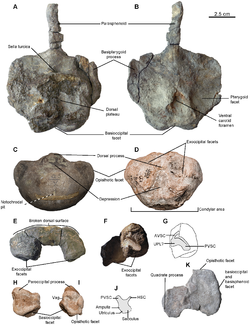| Name | Novelty | Status | Authors | Age | Unit | Location | Notes | Images |
|---|
Alienochelys [30] | Gen. et sp. nov | Valid | de Lapparent de Broin et al. | Late Cretaceous (Maastrichtian) | Oulad Abdoun Basin |  Morocco Morocco
| A sea turtle, a member of Dermochelyoidae. The type species is Alienochelys selloumi. |  |
Allaeochelys libyca [31] | Sp. nov | Valid | Havlik, Joyce & Böhme | Miocene (Langhian) | |  Libya Libya
| A relative of the pig-nosed turtle, a species of the (possibly paraphyletic) genus Allaeochelys. | |
Ashleychelys [32] | Gen. et sp. nov | Valid | Weems & Sanders | Oligocene | |  United States United States
| A pancheloniid sea turtle. The type species is Ashleychelys palmeri. | |
Atolchelys [33] | Gen. et sp. nov | Valid | Romano et al. | Early Cretaceous (Barremian) | Morro do Chaves Formation |  Brazil Brazil
| A bothremydid pleurodiran. The type species is Atolchelys lepida. | |
Brodiechelys royoi [34] | Sp. nov | Valid | Pérez-García, Gasulla & Ortega | Early Aptian | Arcillas de Morella Formation |  Spain Spain
| A xinjiangchelyid, a species of Brodiechelys. | |
Cheirogaster bacharidisi [35] | Sp. nov | Valid | Vlachos, Tsoukala & Corsini | Pliocene | Gonia Formation |  Greece Greece
| A tortoise, originally described as a species belonging to the genus Cheirogaster. Subsequently, transferred by Pérez-García & Vlachos (2014) to the genus Titanochelon . [36] | |
Eodortoka [37] | Gen. et sp. nov | Valid | Pérez-García, Gasulla & Ortega | Early Cretaceous (Aptian) | Arcillas de Morella Formation |  Spain Spain
| A dortokid, a member of the clade Pan-Pleurodira (containing living pleurodirans and all turtles that are more closely related to them than to cryptodirans). The type species is Eodortoka morellana. | |
Gobiapalone [38] | Gen. et comb. et sp. nov | Valid | Danilov et al. | Late Cretaceous (Cenomanian to Maastrichtian) | Barun Goyot Formation
Bayan Shireh Formation
Nemegt Formation |  Mongolia Mongolia
| A trionychine trionychid. The type species is "Amyda" orlovi Khosatzky (1976); genus also contains new species Gobiapalone breviplastra. The genus Gobiapalone was considered to be a junior synonym of the genus Kuhnemys by Georgalis & Joyce (2017), though the authors maintained G. orlovi and G. breviplastra as distinct species within the latter genus. [39] | |
Hylaeochelys kappa [40] | Sp. nov | Valid | Pérez-García & Ortega | Late Jurassic (Tithonian) | Freixial Formation |  Portugal Portugal
| A basal member of Eucryptodira, a species of Hylaeochelys. | |
Judithemys kranzi [41] | Sp. nov | Valid | Weems | Paleocene (early Thanetian) | Aquia Formation |  United States United States
| A member of (likely paraphyletic) group "Macrobaenidae", a species of Judithemys. | |
Nemegtemys [38] | Gen. et sp. nov | Valid | Danilov et al. | Late Cretaceous (Maastrichtian) | Nemegt Formation |  Mongolia Mongolia
| A cyclanorbine trionychid. The type species is Nemegtemys conflata. | |
Osonachelus [42] | Gen. et sp. nov | Valid | de Lapparent de Broin et al. | Eocene (late Bartonian) | Vic-Manlleu Marls Formation |  Spain Spain
| A cheloniid sea turtle. The type species is Osonachelus decorata. | |
Procolpochelys charlestonensis [32] | Sp. nov | Valid | Weems & Sanders | Oligocene | |  United States United States
| A pancheloniid sea turtle; a species of Procolpochelys. |  |
Riodevemys [43] | Gen. et sp. nov | Valid | Pérez-García, Royo-Torres & Cobos | Late Jurassic | |  Spain Spain
| A pleurosternid paracryptodiran. The type species is Riodevemys inumbragigas. | |
Tacuarembemys [44] | Gen. et sp. nov | Valid | Perea et al. | Late Jurassic or earliest Cretaceous | Tacuarembó Formation |  Uruguay Uruguay
| A turtle of uncertain phylogenetic placement. The type species is Tacuarembemys kusterae. | |
Titanochelon [36] | Gen. et comb. nov | Valid | Pérez-García & Vlachos | Early Miocene to early Pleistocene | |  Austria Austria
 Bulgaria Bulgaria
 France France
 Germany Germany
 Greece Greece
 Portugal Portugal
 Spain Spain
 Switzerland Switzerland
 Turkey Turkey
 Malta? Malta?
| A tortoise; a new genus for "Testudo" bolivari Hernández-Pacheco (1917). Genus also contains "Testudo" eurysternum Gervais (1848–1852), "Testudo" ginsburgi de Broin (1977), "Testudo" vitodurana Biedermann (1862), "Cheirogaster" steinbacheri Karl (1996), "Testudo" leberonensis Depéret (1890), "Testudo" schafferi Szalai (1931), "Testudo" perpiniana Depéret (1885) and "Cheirogaster" bacharidisi Vlachos et al. (2014). Genus might also contain "Testudo" gymnesicus Bate (1914). |  |
'Trionyx' baynshirensis [38] | Sp. nov | Valid | Danilov et al. | Late Cretaceous (Cenomanian to Santonian) | Bayan Shireh Formation |  Mongolia Mongolia
| A trionychine trionychid, a species of Trionyx sensu lato. | |
'Trionyx' dissolutus [45] | Sp. nov | Valid | Vitek & Danilov | Late Cretaceous (Cenomanian) | |  Uzbekistan Uzbekistan
| A trionychid, a species of Trionyx sensu lato. | |
'Trionyx' gilbentuensis [38] | Sp. nov | Valid | Danilov et al. | Late Cretaceous (Maastrichtian) | Nemegt Formation |  Mongolia Mongolia
| A trionychine trionychid, a species of Trionyx sensu lato. | |
'Trionyx' gobiensis [38] | Sp. nov | Valid | Danilov et al. | Late Cretaceous (Maastrichtian) | Nemegt Formation |  Mongolia Mongolia
| A trionychine trionychid, a species of Trionyx sensu lato. | |
'Trionyx' shiluutulensis [38] | Sp. nov | Valid | Danilov et al. | Late Cretaceous (Campanian) | |  Mongolia Mongolia
| A trionychine trionychid, a species of Trionyx sensu lato. | |
|














